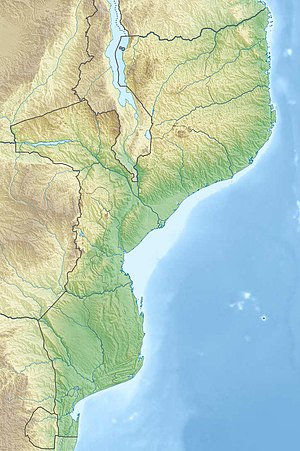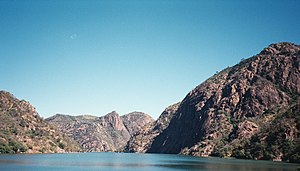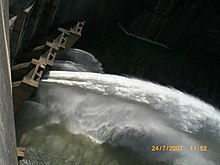Cahora Bassa dam
| Cahora Bassa dam | |||||||
|---|---|---|---|---|---|---|---|
| Satellite image of the reservoir | |||||||
|
|||||||
|
|
|||||||
| Coordinates | 15 ° 35 ′ 9 ″ S , 32 ° 42 ′ 17 ″ E | ||||||
| Data on the structure | |||||||
| Construction time: | 1969-1979 | ||||||
| Height above valley floor: | 165 m | ||||||
| Height above foundation level : | 171 m | ||||||
| Height of the structure crown: | 331.00 m | ||||||
| Building volume: | 510,000 m³ | ||||||
| Crown length: | 303 m | ||||||
| Crown width: | 4 m | ||||||
| Base width: | 23 m | ||||||
| Power plant output: | 2075 MW | ||||||
| Data on the reservoir | |||||||
| Altitude (at congestion destination ) | 326.00 m | ||||||
| Water surface | 2,800 km² | ||||||
| Storage space | 65,000 million m³ | ||||||
| Catchment area | 900,000 km² | ||||||
| Design flood : | 13,600 m³ / s | ||||||
| Cahora Bassa Reservoir | |||||||
The Cahora Bassa dam , called "Cabora Bassa" in colonial times ( Portuguese : Barragem de Cahora Bassa or Hidroeléctrica de Cahora Bassa ), is located in Mozambique , in the province of Tete . It is one of the largest dams in the world.
history
Developments during the colonial period of Mozambique
The first ideal foundations for the dam project relate to the establishment of the Missão do Fomento e Povoamento do Zambesi (MFPZ) ( English : Agency for the Promotion and Settlement of the Zambezi ), a state development institution in Mozambique created in 1957 by the Portuguese government. In 1965 it presented plans for the economic use of the Zambezi Run for the first time .
The anti-colonial liberation movement FRELIMO fought against the dam project right from the start of planning . The West German student movement also joined the resistance with a campaign against Cabora Bassa.
The dam was built between 1969 and 1979 in what was then the Portuguese colony by a consortium of companies, but the main responsibility lay in the hands of the Portuguese machine and power plant construction company Sorefame from Amadora . Electricity deliveries to South Africa began in March 1977. The approximately 165 m high arch dam is located in a mountain bottleneck on the lower Zambezi in Mozambique, about 700 km from its confluence with the Indian Ocean and is mainly used to generate electricity .
Investors and companies from South Africa, France , Germany , Portugal , the USA and Switzerland were involved in the construction project. For this purpose, a joint consortium, the Zambeze Consorcio Hidroelectrico (ZAMCO), was formed, which in 1969 concluded a related contract with the Portuguese colonial administration. South Africa provided the largest share of the financing with a total of £ 105 million , a substantial part of which came from government sources. For example, ESCOM contributed £ 45 million to the project. Additional government money came through the Industrial Development Corporation (IDC). GBP 90 million came from Portugal, GBP 30 million from France and GBP 45 million from Germany, the USA and Switzerland together flowed into the project. The multinational mining company Anglo American Corporation participated with its own construction and transportation companies. South Africa also took a leading position as a consumer of electricity, almost 100 percent, as the only route for electricity supplies led to the industrial conurbation around Pretoria . Mozambique was only able to obtain electricity from the Cahora Bassa dam through systems at Pretoria . As a result, the south of Mozambique was integrated into the energy network of South Africa and became considerably dependent. The South African government made this constellation a condition of the negotiations in the mid-1960s. According to a former IDC director, South Africa was not interested in a power transmission line that could be "tapped" by other sources. Since 1977 the ESCOM and representatives of the Mozambican government in the Permanent Joint Technical Committee (German about: Permanent Joint Technical Committee) exercised the control over the operation of the hydropower plant.
The construction of the plant was welcomed in neighboring South Africa under the impression of the 1973 oil crisis . Henry Olivier, the head of the hydropower energy authority at the time, confirmed in a statement to the Johannesburg Chamber of Commerce his government's intention to build a 1,400-kilometer cross-border high-voltage line from Mozambique in order to keep domestic energy prices low. He also referred to the future capital expenditure for thermal power stations that would have to be avoided and the reduction in pollution in his country.
Developments after Mozambique's independence
The transmission of electricity to South Africa via the HVDC began in May 1975. Acts of sabotage by various groups during the Mozambican civil war between 1981 and 1992 and its aftermath ultimately prevented electricity transmission for 17 years.
It was not until 1998 that electricity production began under Portuguese management. In November 2005, Mozambican President Armando Guebuza announced that Mozambique would take control with a payment of 787.4 million euros . In October 2006, Portugal and Mozambique agreed to US $ 950 million , with which Mozambique increased its stake in Hidroeléctrica de Cahora Bassa (HCB) from 18 to 85 percent. Portugal's share decreased from 82 to 15 percent.
Accompanied by a state act in Songo, the majority ownership of the Cahora Bassa dam, including its hydroelectric systems, passed from the Portuguese side to that of the Mozambican state on November 27, 2007. This festive ceremony was preceded the day before by negotiations on the terms of the contract, which took place at the Joaquim Cissano Conference Center in Maputo . Mozambique still had a balance of US $ 700 million to pay to Portugal. The total contracted volume was $ 950 million. This enabled 85 percent of the shares in the operating company Hidroeléctrica De Cahora Bassa (HCB) to be taken over. In October 2006, US $ 250 million had already been raised from the Mozambican state budget. The remaining amount was secured through a loan agreement with the Canadian consortium Calyon and the Portuguese Banco Português de Investimento (BPI).
At the ceremony, the heads of state took Festus Mogae ( Botswana ), Bingu wa Mutharika ( Malawi ), Armando Guebuza ( Mozambique ), Levy Mwanawasa ( Zambia ) and Robert Mugabe ( Zimbabwe ), and also the South African Vice President Phumzile Mlambo-Ngcuka , the Swazi Prime Minister Absalom Themba Dlamini and the Portuguese Finance Minister Fernando Teixeira dos Santos attended. In Armando Guebuza's speech, he emphasized that the takeover of the dam and its facilities represented the “second independence” for Mozambique. Guebuza added that generating power from Cahora Bassa improves the path for Mozambique's industrialization, as electrical energy can now also reach rural areas from here.
The hydroelectric power station of Cahora Bassa with an installed capacity of 2075 MW contributes significantly to the gross domestic product of Mozambique. At the time of its state ownership, HCB was generating around $ 150 million in annual revenue from electricity sales, primarily to South Africa and Zimbabwe.
After lengthy negotiations, the Portuguese government finally sold its remaining 15% in 2012 for around EUR 74 million in equal parts to the Portuguese electricity grid operator REN and a Mozambican company. The splitting of the shareholders is therefore as follows:
- Mozambican state share: 85 percent,
- Companhia Eléctrica do Zambeze (CEZA), Mozambique: 7.5 percent,
- Redes Energéticas Nacionais (REN) Portuguese share: 7.5 percent.
HCB has a long-term agreement with Eskom ( Power Purchase Agreement - PPA) as well as between Electricidade de Moçambique Empresa Publica (EDM.EP) and the Zimbabwe Electricity Supply Authority (ZESA, now ZESA Holdings ) from Zimbabwe, where the energy goes a high voltage AC power line owned by EDM.
According to the original agreements between South Africa and Portugal, South Africa could expect energy deliveries on extremely favorable terms. However, the increasing demand for electricity in Mozambique temporarily led to the need to buy back the electrical energy required for a secure supply in Maputo at a significantly higher price.
power plant
The dammed water feeds a hydropower plant with an installed capacity of 2.075 GW , the majority of which is sold to the neighboring Republic of South Africa via the 1,420 km long HVDC Cahora Bassa . The cavern power plant has five machine sets with 415 MW each and went into operation in 1975.
The power plant operator is the Mozambican company Hidroeléctrica de Cahora Bassa (HCB), SA, which was founded on June 24, 1975 on the basis of a contract between the Frente de Libertação de Moçambique (FRELIMO) and the then Portuguese government by Vasco Gonçalves .
Reservoir
The reservoir is approx. 250 km long, 2,800 km² in size and has a storage volume of 65 billion m³ (according to Rißler only 63 billion m³). The catchment area covers 900,000 km². This includes the sub-catchment areas of the Kariba dams above with 520,000 km² and Kafue with 150,000 km².
Flood relief
The dam wall has a remarkable flood relief in the lower third of the wall. There are eight armored wall culverts that throw the water jet in a high arc up to 300 m into the river bed. Each passage has a capacity of 1700 m³ / s (together 13,600 m³ / s); the water exits at full load at a speed of 36 m / s.
literature
- Sietse Bosgra: Cabora Bassa. A dam against the Africans. "Cabora Bassa Komitee", Berlin 1972.
- Ulrich Pawlitzki: The relief system of the Zambezi dam Cabora Bassa. In: Wasserwirtschaft, Vol. 70, No. 3, March 1980, ISSN 0043-0978 , pp. 94-97.
- Ulrich Jürgens : Cahora Bassa - past and future of a large water project in southern Africa. In: Geographical Rundschau. Vol. 56, No. 12, 2004, ISSN 0016-7460 , pp. 36-39.
See also
- List of power plants in Mozambique
- List of dams in the world (Mozambique)
- List of the largest dams on earth
- The largest reservoirs on earth
- List of the largest hydroelectric plants in the world
Web links
- HCB: Website of the Hidroeléctrica de Cahora Bassa . on www.hcb.co.mz (English / Portuguese)
- Eskom: The Rationale Behind the Apollo-Cahora Bassa Scheme . on www.eskom.co.za (English)
- Bernd Schröder: Portugal is separating from Cahora Bassa. In: Heise online . December 4, 2005 ( Telepolis ). Retrieved November 6, 2016.
- Bernd Schröder: Cahora Bassa: A dam through the ages. In: Heise online . August 20, 2005 ( Telepolis ). Retrieved November 6, 2016.
- Technical data of the Cahora Bassa dam on www.ilec.or.jp ( Memento from April 26, 2012 in the Internet Archive )
Individual evidence
- ↑ ESMAP: The Potential of Regional Power Sector Integration Cahora Bassa. Generation case study (3rd history of scheme) . London 2009. at www.openknowledge.worldbank.org (English)
- ↑ Pedro Mendonca: Sorefame, shaping steel and progress . on www.mendonca.co (English)
- ↑ Anonymous: Cahora Bassa comes back to life . Posted May 11, 1998 by International Water Power & Dam Construction, online at www.waterpowermagazine.com
- ^ Ronald Meinardus: The Africa policy of the Republic of South Africa . Bonn 1981, p. 286
- ^ Ronald Meinardus: The Africa policy of the Republic of South Africa . Bonn 1981, pp. 286-289
- ^ Cabora - New Energy Hope for SA . In: Star Weekly (South Africa) of December 1, 1973. online at www.mozambiquehistory.net (PDF; 62 kB).
- ^ Siemens 1996-2020: Cahora Bassa. Siemens supplies South Africa with electricity . www.new.siemens.com (English)
- ↑ a b Portugal encaixa 74 milhões com Cahora Bassa ( Portugal takes 74 million with Cahora Bassa ). Article of April 9, 2012 in the Portuguese weekly Expresso , accessed February 1, 2017 (Portuguese)
- ^ A b c Bayano Valy, Southern African Research and Documentation Center (SARDC): Mozambique takes ownership of Cahora Bassa Dam . News from November 2007 in (English)
- ^ Amílcar Cipriano, Colin Waugh, Mathikizana Matos: The Electricity Sector in Mozambique. An Analysis or the Power Crisis and its Impact on the Business Environment ( Memento of the original from January 27, 2018 in the Internet Archive ) Info: The archive link was automatically inserted and not yet checked. Please check the original and archive link according to the instructions and then remove this notice. . USAID / Mozambique, Support Program for Economic and Enterprise Development (SPEED), February 2015, p. 11, online at www.speed-program.com (PDF document p. 11, English)
- ^ Building a Post-Colonial Power System. In: African Business (London), September 1982 at www.mozambiquehistory.net (PDF; 91 kB).
- ^ Gregory Poindexter: Low water levels at 2,075-MW Cahora Bassa hydropower project in Mozambique reduce generation . In: Hydro Review, at www.hydroworld.com (English)
- ↑ HCB: website of the Hidroeléctrica de Cahora Bassa . on www.hcb.co.mz.



